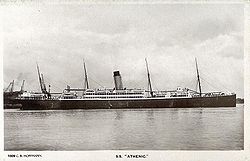Athenic (ship, 1902)
|
||||||||||||||||||||||||
|
||||||||||||||||||||||||
|
||||||||||||||||||||||||
|
||||||||||||||||||||||||
|
||||||||||||||||||||||||
The ss athenic was a 1902 posed in service passenger ship of the British shipping company White Star Line , the passenger and freight traffic from the UK to New Zealand was used. In 1928 the Athenic was sold to Norwegian owners and used as a whaling ship under the name Pelagos . Applied in 1941 by the German auxiliary cruiser Pinguin , it remained under the German flag until it was sunk at Kirkenes in 1944 . It was lifted in 1945 and remained under the Norwegian flag in Hamburg until it was demolished in 1962.
The ship
The 12,234 GRT steamship Athenic was built at the Harland & Wolff shipyard in Belfast and was launched on August 17, 1901. The Athenic was the first of three identical sister ships that were built for the profitable passenger and freight service from London to Wellington (New Zealand). The other two were the Corinthic (1902) and the Ionic (1903). These were the first new orders from the White Star Line after their takeover by JP Morgans International Mercantile Marine Company (IMMC).
The Athenic , like her sister ships, was powered by two four-cylinder quadruple expansion steam engines from Harland & Wolff, which acted on two propellers and developed 604 nominal horsepower. The passenger capacities were 121 in the first class, 117 in the second class and 450 in the third class. The ship was equipped with electric lights and refrigerated chambers for transporting frozen meat.
On January 23, 1902, the Athenic was handed over to her owners after successfully passing test drives and on February 13, 1902 she left London for her maiden voyage to Wellington via the Canary Islands , Cape Town and Hobart . She stayed on the New Zealand route until the outbreak of World War I.
Troop transport in the First World War
On September 23, 1914, the New Zealand Canterbury Mounted Rifles regiment boarded the Athenic in Lyttelton , which it set off on December 3, 1914 after several stopovers in Alexandria . At the time, it was the largest troop transport that shipped New Zealand forces. During the First World War, the ship was marked HMNZT 11 (His Majesty's New Zealand Transport No. 11).
On February 28, 1916, the Athenic took a large number of British prisoners of war on board in Santa Cruz, Argentina , to bring them back to Great Britain. They were crew members of British merchant ships that the German auxiliary cruiser Möve had taken as a prize in the previous weeks . From 1917 to 1919, like her sister ships, she was part of the British government's Liner Requisition Theme (roughly “ship acquisition program”). During this time, however, she remained in civil passenger traffic at the same time. Soldiers were only promoted to third-class accommodations; the first and second class were reserved for regular passengers.
On January 10, 1920, the Athenic set off on her first civil post-war voyage from London via the Panama Canal to New Zealand. On May 3, 1920, she took the passengers and crew of the American liner Munamar on the Munson Line, which ran aground near San Salvador , and brought them to Newport News . In April 1927 the Athenic undertook an unscheduled crossing to Sydney and Brisbane . On October 18, 1927, she ran from Liverpool on her last trip for the White Star Line to Wellington.
Under the Norwegian and German flags
In May 1928 the Athenic was sold to Brunn & von der Lippe, based in Tønsberg . She was converted into a whaling ship by the Smiths Dock Company on Tees in England and was given the new name Pelagos .
The Norwegian shipping company Hvalfangerselskapet Pelagos A / S became the new owner. The action turned out to be so profitable for the White Star Line that the Suevic , Runic and Medic were also sold to the Norwegian whaling industry and, after reconstruction, as Skytteren , New Sevilla and Hektoria (the latter two eventually under the British flag) Ride came.
On January 15, 1941, the Pelagos was captured by the German auxiliary cruiser Pinguin together with the other mother ship Ole Wegger , the supply ship Solglimt and 11 fishing boats and sent to Bordeaux except for one fishing boat , where it arrived on March 11, 1941 as the first ship of the whaling fleet . She was assigned to the 24th submarine flotilla stationed in Norway as a tanker. On October 24, 1944, she was sunk by a German submarine in Kirkenes when the German troops withdrew from the Soviet troops and left behind "scorched earth".
In 1945 the Norwegians lifted the ship again. After repairs, the Pelagos was used again as a whaling ship. In 1962 the 60-year-old ship was scrapped at Eckardt & Co. in Hamburg .
literature
- Erich Gröner, Dieter Jung, Martin Maass: The German warships 1815-1945, Vol. 4: Auxiliary ships I: Workshop ships, tenders and escort ships, tankers and suppliers, Bernard & Graefe Verlag, Koblenz 1986, ISBN 3-7637-4803-2 , P. 33 f.
Web links
- Description of the ship in The Ships List (approximately in the middle)
- The three sister ships Corinthic , Athenic and Ionic



